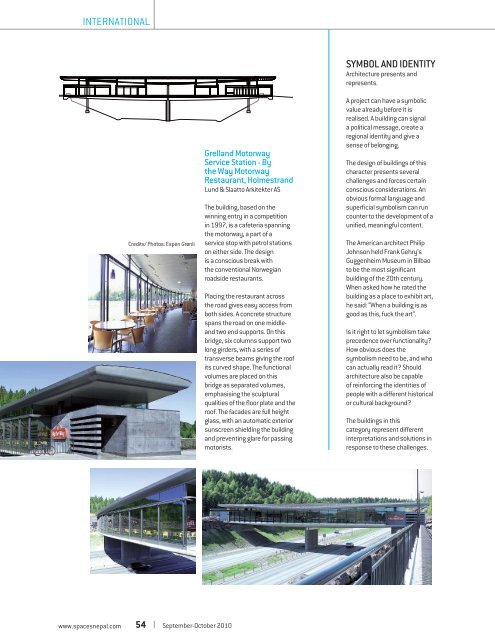5. September - October 2010
You also want an ePaper? Increase the reach of your titles
YUMPU automatically turns print PDFs into web optimized ePapers that Google loves.
INTERNATIONAL<br />
Credits/ Photos: Espen Grønli<br />
Grelland Motorway<br />
Service Station - By<br />
the Way Motorway<br />
Restaurant, Holmestrand<br />
Lund & Slaatto Arkitekter AS<br />
The building, based on the<br />
winning entry in a competition<br />
in 1997, is a cafeteria spanning<br />
the motorway, a part of a<br />
service stop with petrol stations<br />
on either side. The design<br />
is a conscious break with<br />
the conventional Norwegian<br />
roadside restaurants.<br />
Placing the restaurant across<br />
the road gives easy access from<br />
both sides. A concrete structure<br />
spans the road on one middleand<br />
two end supports. On this<br />
bridge, six columns support two<br />
long girders, with a series of<br />
transverse beams giving the roof<br />
its curved shape. The functional<br />
volumes are placed on this<br />
bridge as separated volumes,<br />
emphasising the sculptural<br />
qualities of the floor plate and the<br />
roof. The facades are full height<br />
glass, with an automatic exterior<br />
sunscreen shielding the building<br />
and preventing glare for passing<br />
motorists.<br />
SYMBOL AND IDENTITY<br />
Architecture presents and<br />
represents.<br />
A project can have a symbolic<br />
value already before it is<br />
realised. A building can signal<br />
a political message, create a<br />
regional identity and give a<br />
sense of belonging.<br />
The design of buildings of this<br />
character presents several<br />
challenges and forces certain<br />
conscious considerations. An<br />
obvious formal language and<br />
superficial symbolism can run<br />
counter to the development of a<br />
unified, meaningful content.<br />
The American architect Philip<br />
Johnson held Frank Gehry’s<br />
Guggenheim Museum in Bilbao<br />
to be the most significant<br />
building of the 20th century.<br />
When asked how he rated the<br />
building as a place to exhibit art,<br />
he said: “When a building is as<br />
good as this, fuck the art”.<br />
Is it right to let symbolism take<br />
precedence over functionality?<br />
How obvious does the<br />
symbolism need to be, and who<br />
can actually read it? Should<br />
architecture also be capable<br />
of reinforcing the identities of<br />
people with a different historical<br />
or cultural background?<br />
The buildings in this<br />
category represent different<br />
interpretations and solutions in<br />
response to these challenges.<br />
www.spacesnepal.com 54<br />
<strong>September</strong>-<strong>October</strong> <strong>2010</strong>

















